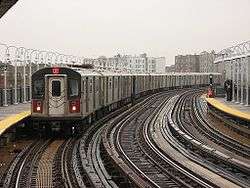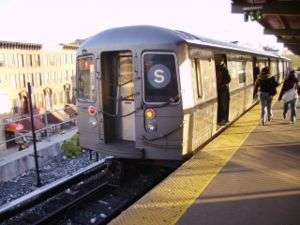R110B (New York City Subway car)
| R110B | |
|---|---|
|
R110B railcar used in NYCTA Training Center | |
| In service | 1993-2000 |
| Manufacturer | Bombardier Transportation[1] |
| Constructed | 1992 |
| Entered service | June 15, 1993 |
| Number built | 9[1] |
| Formation | Three-car sets[1] |
| Fleet numbers | 3001-3009 |
| Capacity | 54 seated 183 standing (A car), 50 seated 175 standing (B car)[1] |
| Operator(s) | New York City Subway |
| Specifications | |
| Car body construction | Stainless steel[1] |
| Car length | 67 ft (20.42 m)[1] |
| Width | 10 ft (3.05 m)[1] |
| Height | 12.08 ft (3.68 m)[1] |
| Doors | 8 |
| Maximum speed | 55 mph (89 km/h)[1] |
| Weight |
Trailer (71,000 lb (32,000 kg)) Motorized (86,000 lb (39,000 kg))[1] |
| Traction system | General Electric AC Traction motors: Model GEB 7-B, 202 hp (151 kW), 3 Phase, 4 Pole |
| Electric system(s) | 600 V DC Third rail[1] |
| Current collection method | Contact shoe |
| Safety system(s) | emergency brakes |
| Track gauge | 4 ft 8 1⁄2 in (1,435 mm) standard gauge[1] |
The R110B (contract order R131) was a prototype class of experimental new technology New York City Subway cars built by Bombardier of Canada for service on the IND and BMT (B Division) services delivered in 1992 and entered service on June 15, 1993 on the A service. The R110B was designed to test various new technology features that would eventually be incorporated into the R143 and was not intended for long-term production use.
Description
The nine R110B cars were ordered from Bombardier in December 1989.[1]
There were nine R110B cars, numbered 3001-3009. The cars were linked into three-car sets by consecutive numbers. The cab cars are powered with four traction motors each, while the center car of the 3-car set is an un-powered, cab-less trailer. The cars are typical B-Division size, except that they are 67 feet long, a length shared by the BMT Standards, and the SIRT ME-1, along with all of the SEPTA's Broad Street Subway cars and the current PATCO fleets.
The R110B uses the standard subway train control stand, but with some added computerized features. The layout of the controls is desk-style, with switches, lamps, and a single lever to control traction and braking. A CRT with function keys on either side is used to monitor speed, train status, etc.
The R110B's design is similar to that of the R68 cars now in use on the BMT and IND lines, but the ends are more square and use Lexan glass in the windows. Car ends that do not have cabs have an expanse of glass, which makes the car feel open and airy. The seating configuration is the same as in the R68, but the materials are more advanced.
A matte plastic is used that allows scratches, tags and stubborn graffiti to be buffed out using a light abrasive. The seats have a reduced bucket. Internal surfaces are tan fiberglass and plastic, with accents provided using a plastic mosaic applique. The floor uses linoleum with a pattern of slightly raised and textured squares. The R110B cars have handholds for shorter passengers.
There are rollsign line indicators in the front of the train, LCD destination signs (on windows) and interior strip route guides on top of the ad space, and LED indication of stops ahead on both sides.
Another new and important feature was the passenger intercom, which could be used for emergencies.
Accident
On November 4, 1996, a fire and explosion occurred on car 3006 while the train was in service on the A train. This resulted in set 3007–3009 being permanently taken out of service and cannibalized of parts to repair car 3006 and to keep the other two sets operating. The two remaining sets (3001-3003 and 3004-3006) ran as a six-car train on the C route.
Retirement and Current Status
Throughout 1999, the remaining R110Bs had been in and out of service for both repairs and additional component testing. The train was permanently removed from service in 2000 due to frequent breakdowns and low Mean Distance Between Failure (MBDF) numbers, and never ran in service again.
After retirement, many of the cars were reused throughout New York City, including:
- 3001, sent off to College Point, Queens in early 2014 for use as a training car for the NYPD. Part of the car was cut away to allow the car to fit in the building.[2] It most likely replaced R33s 9156-9157.
- 3005, used as a training car at P.S. 248, the New York City Transit Learning Center, since July 15, 2004. This car replaced R16 #452.
- 3004 and 3006, used as training cars at the Coney Island Yard's firefighting facility since August 2004. These cars replaced R30s 8392 and 8401.
- 3008, spotted in late August 2015 near FDNY's Randall's Island training facility. This car may replace older cars there.
Cars 3002-3003, 3007, and 3009 are currently stored at the 207th Street Yard.[3][4][5][6] Plans are unknown for these cars; however, with recent movements of several cars, it is likely that more will be taken off property to various locations in the near future.
References
- 1 2 3 4 5 6 7 8 9 10 11 12 13 "Rapid Transit Car R-110B". Bombardier Incorporated. 1990. Retrieved October 23, 2016.
- ↑ "Log in". Instagram.
- ↑ http://www.nycsubway.org/perl/show?63068
- ↑ http://www.nycsubway.org/perl/show?63064
- ↑ http://www.nycsubway.org/perl/show?63060
- ↑ http://www.nycsubway.org/perl/show?63048
Further reading
- Sansone, Gene. Evolution of New York City subways: An illustrated history of New York City's transit cars, 1867-1997. New York Transit Museum Press, New York, 1997 ISBN 978-0-9637492-8-4



